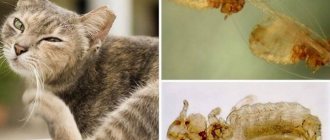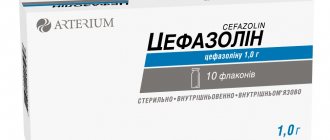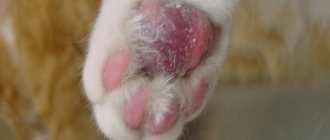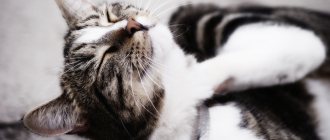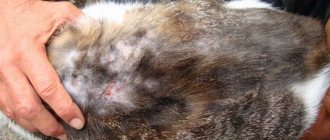Unfortunately, we cannot always protect our pets from injury. Troubles especially often happen to cats that often walk outside. Bites and lacerations are a common consequence of feline territorial disputes. And if such wounds are not treated in time, they can fester. In this article we will tell you how to distinguish purulent wounds in cats from ordinary ones, what to do if a cat’s wound festers, and how to treat a festered wound in a cat.
Wounds are one of the most common injuries in cats. A cat can get hurt on sharp objects, or it can get injured in a fight. Depending on the nature of the wound, cut, stab, lacerated, bruised and bitten wounds are distinguished. If the wound is small, then after a little treatment with a disinfectant (it is best to use chlorhexidine), it will completely heal on its own. Large and complex wounds, such as lacerations and bite wounds, require a visit to your veterinarian.
Regardless of whether the wound is small or large, whether you handle the cat yourself or go to the veterinary clinic, the wound must be treated. To do this, the cat's hair is trimmed around the wound, the wound is washed (at home, we recommend using chlorhexidine, which will definitely not harm your cat, unlike peroxide or iodine with brilliant green, which can cause extensive burns of the skin and deeper tissues), and removed from foreign objects, apply a sterile bandage. If this is not done, pathogenic bacteria may enter the wound. In this case, suppuration will begin.
Purulent wounds in cats are divided into open and closed. If the wound is open, nothing prevents the flow of pus. A closed wound turns into an abscess - a cavity in which pus accumulates. Pus is a cloudy exudate that accumulates in an inflamed wound. Typically, the pus is yellow or yellow-green in color. This substance consists of the so-called “purulent serum” (dissolved blood proteins, enzymes, lipids), tissue detritus and cells of pathogenic microorganisms and leukocytes. Microorganisms that cause suppuration are almost always found in the pus. Most often these are various bacteria (staphylococci, streptococci, E. coli, gonococci and others), but purulent inflammation can also be caused by other microbes, for example mycobacteria, candida, actinomycetes.
Drugs
Today, in the pharmacy chain you can purchase a large number of medications that disinfect the wound. Accordingly, the choice of medication directly depends on the wound surface, its size, depth and the possibility of further infection. Treatment measures, prevention of secondary infection and eradication of surface healing depend on these factors.
Hydrogen peroxide
Treatment with this drug is possible no later than 2 hours from the moment of injury. Do not pour the bottle directly onto the wound. It is better to moisten the swab with the solution and treat the surface. If possible, apply a sterile dressing. But remember that during treatment you must hold your pet tightly.
Owner's actions to treat the wound
If there is a cat with mammary cancer in the house, then the owner should know how to treat the cat's tumor. Veterinary experts recommend treating an unopened tumor without signs of infection with a chlorhexidine solution or a 0.5 - 1% furatsilin solution. Migstim spray is easy to use.
The drugs used will not have a therapeutic effect on the cancerous tumor, but will slow down the development of purulent-necrotic processes in the affected organ and alleviate the general condition of the pet.
Ointments are used only after thorough drainage of the pathological focus. To treat the surface of oncological ulcers, the following agents are used:
- "Levomikol"
- "Sulfargin"
- "Solcoseryl"
- "Actovegin"
- “Oflocaine.”
The choice of one or another product must be agreed with a veterinary specialist.
If a tumor has been opened in a sick animal, the owner should immediately contact a veterinary institution to provide qualified assistance. If for some reason a visit to a veterinarian is not possible in the near future, the owner should know how to treat neoplasms on the chest of cats. The following antiseptic solutions are suitable for these purposes:
- ready-made chlorhexidine solution,
- 1% solution of furatsilin,
- 2 - 5% solution of potassium permanganate, etc.
You can wash the ulcers and the exposed tumor with sterile saline solution.
The 3% solution of hydrogen peroxide, iodine tincture, alcohol solution of brilliant green, and Miramistin, which are widely used in everyday life, should not be used for the treatment of ulcers of oncological origin because of their high concentration. These antiseptics damage granulation tissue and have a toxic effect on healthy cells.
Cat blanket
If a cat has a tumor, how to remove the smell is a question often addressed to the veterinarian by owners caring for sick animals in the final stages of the disease.
Opening a tumor is almost always accompanied by an unpleasant putrefactive odor. This phenomenon is due to the fact that cancer ulcers are poorly aerated, as a result of which anaerobic microflora develops, giving the cancer tumor a specific odor. The decomposition of protein and sulfur-containing amino acids that make up the protein structure of tissues causes a sharp putrid stench from a sick animal.
To reduce this phenomenon, the owner should regularly monitor the cleanliness of the exposed tumor, remove necrotic tissue, drain open wounds, and treat ulcerative surfaces with antiseptic solutions. To remove putrefactive odor, apply sterile dressings and replace them as they become dirty.
After antiseptic treatment and application of ointments, the animal should wear a blanket to avoid contamination of the open wound and licking of the pathological focus.
How to care for a cat during the recovery period?
Watch the cat. If the wound was small and the animal immediately received adequate help, there should be no lethargy, drowsiness, vomiting, diarrhea or other “strange” signs. In the event that you observe something similar to your slightly injured pet, immediately call a veterinarian. These clinical signs clearly indicate a sharp deterioration of the pathological process.
Important! Discourage your cat from constantly trying to scratch the wound, tighten the post-operative bandage, or remove the drainage from the wound channel. Let us note, by the way, that for any wound, cats need a surgical (aka Elizabethan) collar, since otherwise they will definitely lick the damaged tissue.
If your pet is completely restless, it is recommended to use “aggressive” models that give a slight electric shock when trying to get rid of the collar. T-shirts and rompers for babies can be used as a “budget option”: if the animal is pulled into them, it will no longer be able to reach the wound (well, at least it will get very tired). Of course, the “clothes” need to be changed more often.
If you see that the edge of the drainage has appeared from the canal , be sure to inform the treating veterinarian about this. It is believed that the ideal time to replace drainage is every 12 hours. But in reality, it is rare that an owner can take a pet to the veterinarian with such frequency. There are two ways out: either do the replacement yourself, or extend the period to 17-20 hours. In principle, there is nothing wrong with this. If the wound looks clean, dry and closed, you can leave the drainage system without any fear: nothing bad will happen. Just make sure your cat can't lick the wound.
Tumor treatment
A favorable prognosis for a malignant mammary tumor in a cat is only possible if it is surgically removed at the initial stage of the disease, in the absence of metastases. In this case, excision of the tumor is usually accompanied by the removal of nearby lymph nodes and the capture of a significant part of healthy tissue. Resection can involve either one side of the mammary glands or the entire organ of the animal. In this case, the veterinarian usually removes the tumor in several stages.
Surgical excision of even one part of the mammary gland is a rather difficult operation. But often this is the only chance to cure the animal. Veterinary medicine also involves chemotherapy in animals with cancer and radiation. The use of special drugs is effective, as a rule, after surgical resection of a cancerous tumor.
The isolated use of chemotherapy drugs as anticancer therapy does not produce a significant effect and is rarely used in veterinary oncology practice.
Removing a mammary tumor from a cat
However, in most cases, an insidious disease in pets is discovered late, often when a cancerous tumor is opened due to the development of necrotic processes. In this case, the prognosis is usually unfavorable, and treatment is aimed at alleviating the animal’s condition.
First of all, attention is paid to neoplasm. In consultation with a veterinarian, owners will find out how to treat a revealed tumor in a cat. Much attention should be paid to proper feeding of the sick animal and fortification.
Immunostimulating drugs, painkillers and antibacterial drugs are used as prescribed by a veterinary specialist.
To learn how to diagnose and treat a mammary tumor in a pet, watch this video:
Processing rules
As a rule, a cat receives a wound on the street while defending its territory or during the period of sexual heat. The resulting wounds can be of a different nature.
Weeping wound
Weeping wounds are treated dry, provided that the pet does not remove the bandage. If there is purulent exudate, you can apply a gauze pad soaked in a hypertonic solution of table salt or Vishnevsky ointment to the wound. But such treatment will be successful only if tissue regeneration is going well.
If there is no improvement, then surgery should be resorted to to resect the necrosis.
Deep
If the wound surface is deep enough, then treat it with a solution of Chlorhexidine or Miramistin, carefully inserting the nozzle of the bottle into the wound. Next, you need to inject Levomekol ointment into the cavity using a syringe without a needle. Procedures must be performed 2-3 times a day until complete healing. You should also put on a special collar for your pet so that he does not further injure the wound surface by licking it.
In any case, try to get an appointment with a veterinarian as soon as possible to adjust the treatment.
Open
The first step is to treat the surface with hydrogen peroxide. If the wound surface is large and without purulent discharge, then you can treat it with Novocaine solution for pain relief, just by pouring a little on it. Then you can sprinkle streptocide powder on it, it disinfects the surface and promotes speedy healing.
Bleeding
The first step is to stop the bleeding. To do this, clamp the surface with your hands or bandage it tightly. You can also apply a tourniquet above the injury and attach a note indicating the time of application. The tourniquet should not be on the wound for more than 2 hours. For shallow wounds, treat with hydrogen peroxide.
Important! Do not use disinfectants as they can cause severe irritation and slow down healing.
After emergency measures are taken, the animal should be taken to the clinic for treatment.
With purulent discharge
Hydrogen peroxide or chlorhexidine are suitable for disinfection. To prevent the spread of infection, you can give an injection of an antibiotic, for example, Sinusol 50 mg. The full course of treatment is 7 days.
What does the veterinarian do?
- After examining the wound, the specialist carries out his treatment, adhering to all the rules of purulent surgery, asepsis and antisepsis. If necessary, stitches are applied (skin, sometimes muscles with blood vessels are sewn). When sewing, local anesthesia or anesthesia must be used, depending on the complexity of the surgical operation and the location of the injury. The sutures are removed after 10-14 days or are not removed if they were applied with self-absorbable suture material.
- When applying sutures, a small hole must be left so that there is a drain for the resulting wound fluid (exudate), which should not remain in a blind wound, because this will definitely cause suppuration and the formation of a purulent abscess.
- In case of extensive wounds and the presence of pus, a course of antibiotic therapy with broad-spectrum antibacterial agents must be prescribed to avoid sepsis (most often it is ceftriaxone diluted with novocaine, since in cats lidocaine should be used with extreme caution or oxytetracycline if daily injections are not possible).
- A protective bandage may or may not be applied. Everything will depend on the condition of the wound and its accessibility to licking, as well as on the part of the body where it is located. In areas of constant mechanical irritation, it is better to try to apply a bandage, and to prevent licking, you can put on a special collar. Open wounds heal somewhat faster than closed and bandaged wounds, especially for purulent processes, because suppuration is most often caused by anaerobic bacteria (reproducing without access to air), and oxygen in this case will additionally kill them.
- In case of extensive blood loss, the veterinarian prescribes drips to replenish the lack of blood plasma.
- Bite wounds are often accompanied by the formation of abscesses - limited cavities filled with pus. Such areas are opened and necessarily drained, i.e. an area is formed for the drainage of inflammatory exudate, which cannot close until the inside of the wound is completely cleansed. Through the holes, the wound is washed daily with a 3% hydrogen peroxide solution until the wound is clean. Then the drainage is removed, the wound is treated like a normal injury until complete healing.
- In rare cases, a skin transplant may be required if your internal resources for restoring the skin are not enough.
- The average healing time for a wound in a cat (uncomplicated and medium-sized) is 7-16 days. But you need to understand that this period is quite arbitrary and each organism is very individual, so the time frame may increase. In this case, dynamics are important - if the healing process is obvious, then time is not so important.
- If the healing process is under the constant supervision of a specialist, then ongoing adjustments and changes in medications are possible to increase its effectiveness. In case of prolonged non-healing and absence of positive dynamics (more than 3-4 weeks), bacterial culture from the wound may be necessary (not only from the purulent discharge itself, but from places on the border between the wall of the beginning of the purulent process and the discharge itself).
The diet of a cat with purulent wounds also affects the treatment of purulent wounds in cats
A cat with festering wounds is very sensitive
. All smoked meats, sausages, sweets that should not be given to even healthy cats, and fatty meats should be removed from the diet. A festering wound will heal faster if you eat healthy, natural foods, for example, vegetables, boiled chicken, and fish. Remember healthy, dietary food in hospitals and sanatoriums. You will never find sausage or unhealthy smoked brisket there. During the period of active recovery, it is very advisable to give your pet synthetic vitamins that will help maintain the health of the furry.
How to speed up wound healing
To speed up the healing of the wound surface, you should strictly follow the veterinarian’s recommendations. You can also use special long-acting wound-healing wipes for cats, for example, Antivtex. The use of antibiotics prescribed by a doctor will also promote rapid regeneration of the surface.
In addition, it is necessary to provide the animal with complete rest and prevent licking the surface. To do this, you need to use special collars and tightly secured gauze bandages that the pet cannot remove on its own.
Possible complications
Through the scratches of a domestic cat, a person can become infected with many rather unpleasant infections. One of them is felinosis or cat scratch disease. This type of pathological process is characterized by acute bacterial damage to the body.
A cat's claws, located at a special angle, easily penetrate the skin, injuring several layers of the dermis at once. Pathogenic microorganisms located on the paws and claws of an animal penetrate the human body. Animal saliva contaminated with foreign bacteria can also provoke the development of felinosis in humans.
The infection caused by Bartonella adapts perfectly in the animal’s body, circulating in urine, bloodstream and saliva. Naturally, bartonellosis is also found on cat paws.
In the first stages of felinosis development, a person experiences an inflammatory process in the tissues of the lymph nodes. In cats, bartonellosis is transmitted through the bites of blood-sucking parasites. After damage to the tissues of the lymph nodes, edema develops, body temperature increases, signs of poisoning and even an allergic reaction arise.
Felinosis poses the greatest danger to young children and adults with weakened body defenses (especially after suffering from a dangerous disease). It is important to note that BCC is not transmitted from person to person.
There are several forms of felinosis - typical and atypical. The first type of disease is characterized by moderate development. At the site of the injury (healed), a small blister begins to form, which bursts and forms a small ulcer covered with a crust. A person’s well-being does not change much.
Reasons why a tumor opens up
Breast tumors are malignant in 85% of cases. Veterinary medical practice shows that even benign neoplasms develop into a malignant form over time. There are two types of clinical manifestations of mammary gland cancer in cats: nodular and diffuse. Approximately a third of animals are susceptible to single nodular neoplasms. About 70% of animals suffer from the multinodular form of the disease. Diffuse cancer is less common in cats and has a poor prognosis.
Breast cancer in cats
When a breast cancer tumor forms, pathological cells grow into the tissue of the organ. Proliferating diseased cells produce toxic substances, poisoning neighboring healthy tissues. Due to the specific function it performs, the mammary gland is densely penetrated with blood capillaries and lymphatic vessels. The glandular structure of the organ promotes the rapid involvement of healthy cells in the pathological process.
Ulceration of breast tumor
With the development of a malignant tumor, toxic products destroy the membranes of healthy cells, including blood and lymphatic vessels. This leads to the fact that neoplasms appear, causing anxiety and pain to the pet.
Sick animals often lick the affected area, and in case of severe pain they try to gnaw out the growing tumors. This behavior is often the reason why a cat's tumor has ruptured.
Tumor tissue, unlike healthy glandular tissue of the mammary gland, receives little nutrition and is practically not supplied with oxygen. This leads to the emergence of necrotic processes in tumor nodes. The subcutaneous tissue becomes thinner, ulcerated, and a cancerous tumor opens.
The manifestation of the tumor is observed, as a rule, at the last, fourth stage of the oncological process. Before opening the tumor, its bleeding and severe pain are also noted. The highest stage of breast cancer is characterized not only by the appearance of ulcers, but also by metastasis processes. Pathological neoplasm cells enter the circulatory system and lymphatic bed, spread throughout the body, forming metastases.
Therefore, if the owner observes that the cat’s tumor has burst, then this phenomenon indicates that the disease has become incurable. Further actions should be aimed at improving the animal’s quality of life, pain relief, prevention of bacterial and viral infections, and symptomatic treatment.
We recommend reading about why a cat won't eat. You will learn about possible reasons for refusing food, diagnostic measures, and treatment in the hospital. And here is more information about what to do if your cat has bloody urine.
Treatment with antibiotics
Antibacterial drugs are used to prevent secondary infection. As a rule, the remedy is selected by a veterinarian depending on the wound surface. The doctor will also prescribe the exact dosage. The most commonly prescribed drugs are tetracyclines, Ampicillin, Streptomycin. For infection of the wound surface, Amoxicillin, Clindamycin or Benzylpenicillin are recommended.
To summarize, we can say that only a veterinarian can determine how to treat a cat’s wound for effective treatment. After all, the healing process directly depends on correctly selected drugs. In any case, after providing emergency care to your pet, it must be shown to a specialist. Only a veterinarian can prescribe medications that will speed up the healing process and prevent secondary infections from occurring.
How to treat a wound, instructions from a veterinarian
Causes of various damages
Cats receive various injuries mainly on the street. When communicating with other animals, pets often get into fights. This happens especially often during the period of sexual desire, when males defend their territory. Wounds from the enemy in such cases are of a different nature.
Problems are more likely to occur in cats that socialize freely with other pets.
To prevent such collisions, veterinarians recommend spaying and neutering for pets. In this case, cats become calmer and less likely to get into unpleasant situations.
During a fight, animals release sharp claws and teeth, which can leave deep wounds. If a pet gets into such a brawl, then the wounds can be either superficial or lacerated. The most dangerous injuries cats receive are as a result of deep bites, into which infection penetrates and infection occurs. Not only other cats, but also dogs can attack pets. In this case, the damage will be more serious, since the dog’s teeth leave deep marks on the body.
Owners often have questions about how to treat a cat’s wound after an encounter with cruel people. Since any object can be the weapon of a crime, wounds can be punctures, lacerations and bruises. In rare cases, gunshot injuries occur.
Important! Bruises, fractures and scratches occur due to falling from a height or being hit by a car. Pets often suffer chemical burns as a result of toxic substances.
At home, pets get injured due to household appliances, falling from high furniture or interacting with sharp objects. Sometimes cats scratch small wounds, which subsequently leads to serious damage and infection.
Why you shouldn't ignore cat scratches
The causative agent of lymphoreticulosis, or non-bacterial lymphadenitis, lives in the body of many cats. At the same time, the animal itself is not sick and looks cheerful and healthy. The infection is transmitted to humans through scratches and bites. If, despite all the measures you have taken, the scratches begin to become inflamed, reddened or rotted, consult an infectious disease specialist.
Based on the results of the examination, you will be prescribed treatment. Most often, the doctor prescribes antibiotics for internal and external use. The course of treatment depends on the severity of the disease and ranges from 7 to 14 days.
Do you want to avoid such consequences from communicating with your beloved Murka? Get your cat vaccinated on time. It is worth noting that even a vaccinated animal can become infected again if it goes outside unhindered. Therefore, you should not let your guard down. After all, even their beloved owner can be scratched.
How to recognize an abscess: symptoms
The main sign of purulent inflammation is a soft lump filled with fluid. It may appear on the neck, ear, stomach, paws or other damaged part of the body. The appearance of redness at the site of swelling is acceptable, but is not the main symptom.
An abscess in a kitten and an adult animal is always accompanied by pain. Both the suppuration itself and neighboring tissues can hurt. The pet will try to avoid touching or react aggressively to it. If the gums are damaged, a complete refusal to eat is possible, and if the paws are damaged, the affected limb can be pressed in while walking.
Other alarming symptoms will help you suspect something is wrong:
- local baldness;
- a pungent odor emanating from the abscess, or the discharge of pus mixed with blood;
- an increase in local and then general body temperature.
If you notice at least one of the listed symptoms, be sure to contact your veterinarian. It will help remove accumulated pus, eliminating subsequent complications.
Felinoz and cats
There is a disease called felinosis, which is also called cat scratch disease. Felinosis develops under the influence of bacteria that are introduced under the skin from an infected cat. If a cat is sick, then by licking, biting or scratching it can make a person infected, and after this quite unpleasant effects begin to develop.
- The initial stage is contact with the cat.
- Next, swelling and a small ulcer appear.
- After at least one week, a slight fever and inflammation of the lymph nodes begins.
- The lymph nodes become painful, they swell a little, and may have suppuration.
- A rash, tonsillitis and other inflammations develop.
- Some special diseases, such as Parinaud's conjunctivitis, are possible.
- Leukocytosis, lymphocytosis.
- Biopathology.
In general, scratches from a cat themselves are quite specific; they break through layers of epithelium in a row and are quite deep. If such a scratch begins to heal, a closed wound is formed, that is, pus and bacteria accumulate in the cavity. Therefore, such wounds need to be washed and further treated so that the scratch heals without the need for the body to process pus and bacteria.
Treatment at home for an open wound
Treatment of open wounds on a cat begins with the generally accepted principles of treatment, namely by cleansing them of dirt, debris and all foreign bodies. And only then is treatment with an antiseptic drug carried out.
Its subsequent healing depends on how correct the treatment of an open wound is. Excellent antiseptics are chlorhexidine, fucorcin and furatsilin. They are safe and do not cause burns upon contact with the affected area.
Open wounds should not be treated with iodine, brilliant green and alcohol-containing preparations, as they can aggravate the condition of the wound, causing a chemical burn. They are only suitable for treating the skin around the wound.
If your pet has an open wound, first aid should be provided by a veterinarian, because very often the wound needs to be sutured. But if more than twelve hours have passed since the injury, then suturing is no longer done.
Symptoms of felinosis
From the beginning of contact with the cat, felinosis does not manifest itself in any way. A small spot forms at the site of the scratch, which later develops into a papule and a small ulcer. The wound heals very slowly and constantly festeres. Its surface remains moist despite the use of healing agents.
Swelling or swelling occurs at the site of the scratch. The following symptoms occur occasionally :
- allergic reaction;
- toxicosis;
- painful sensations in the bones and body;
- fatigue;
- insomnia.
After three weeks, a person develops a fever, which is the first sign of damage to the body. Lymph nodes in the armpits and elbows become enlarged, and upon palpation they cause discomfort and even pain. Possible suppuration, tonsillitis and a red rash.
What is an abscess in a cat in simple words?
When pyogenic microbes penetrate through damaged skin or mucous membranes in the superficial or deep layers of tissue, an abscess (abscess) forms in the cat. It is a limited cavity filled with pus. The exudate that accumulates as a result of inflammation gradually corrodes the protective capsule, increasing the affected area.
Causes
Among the gaping wounds are the following:
- Chipped.
- Cut.
- Bitten.
- Torn.
- Firearms.
- The result of the action of toxic substances is a mixture.
Stab and cut injuries are characterized by smooth edges and severe bleeding. Lacerations and bitten wounds are characterized by a large area of damage and minor hemorrhage. Cats get them during a fight. Injuries from pneumatic weapons inflicted by animal torturers cannot be ruled out. Caustic substances cause skin burns. The defects become infected and mixed forms are formed.
With closed injuries, swelling and discoloration of the injured area are observed, and internal bleeding cannot be ruled out.
The wound has festered
Processing technique
Therapeutic measures for the treatment of minor defects and festering or bleeding wounds differ.
Treatment of minor injuries
The procedure for treating the defect is represented by the sequential execution by the cat owner of the following steps:
- Hand preparation. They are washed with soap.
- Trimming the hair around the wound with sterilized scissors.
- Remove dirt with a small amount of water.
- Impregnation of a tampon or cotton pad with antiseptic material.
- Treatment of wound edges.
- Applying a bandage.
Laceration
Treatment of purulent wounds
A positive result is achieved using the following steps:
- Removing exudate from the surface.
- The use of an external agent that has antimicrobial, healing, anti-inflammatory properties, and also helps remove pus.
- To speed up the healing of the defect and prevent the formation of rough scars, I use enzymes.
First aid for bleeding.
If scarlet blood is pulsating on the paw, a tourniquet is applied above the wound site. For venous hemorrhage, characterized by a dark color and light bleeding, applying a cotton-gauze bandage treated with an antiseptic helps.
The wounded paw was bandaged
Diagnostics
Large wounds are fairly easy to diagnose on your own. They heal well with regular antiseptic treatment, the amount of purulent contents decreases, and the animal behaves calmly.
Only a veterinarian can diagnose a fistula or abscess. You should show the cat to a specialist as soon as possible, since a fistula can lead to the development of dangerous complications. For an accurate diagnosis, X-rays or MRIs with contrast are done.
Popular Are cat tongue ulcers dangerous?
How to tell if a cat has wounds
How to clean a cat’s ears at home: options for how and what to wash with
Symptoms of damage to a cat:
- The wound site begins to bleed. The intensity depends on the nature of the wound. The most dangerous are: chipped, cut and crushed.
- The integrity of the skin is compromised.
- A puncture wound with a small hole is difficult to identify at first, so you need to navigate by your pet’s wet fur.
- In case of large wounds, there is no hair on the affected area.
- The wounded area swells.
- The wound causes discomfort to the cat, so the animal behaves restlessly and shows aggression if the owner touches the affected area.
- With complex injuries, there may be an increase in temperature, the appearance of pus and redness.
In accessible places (ear, nose, back), it is much easier to notice the presence of wounds than, for example, on the stomach or paws.
It is necessary to examine your pet after every walk
What to do?
If the wound is deep, immediately run to the vet! Scratches can also be treated at home.
It should be remembered that the skin on a cat’s neck is very mobile, prone to folding. This provokes the formation of abscesses, but they do not heal without drainage. In case of minor injuries, in order to avoid suppuration, treatment must be carried out regularly. In case of large ones, drainage installation, if necessary, is carried out by clinic specialists.
A wound on the cat's neck may appear as a result of scabies (subcutaneous sarcoptic mite). In this situation, you must first cure the cat of this parasite, and only then deal with its wounds on the neck.
Minor scratches do not require human intervention. Cat saliva contains lysozyme, which prevents the development of opportunistic microbes. If the cat received a minor injury during a fight, it is calmed down, caressed, the hair at the site of the injury is trimmed, and the defect is treated with an antiseptic.
If the paws are injured, apply a bandage to protect against infection, so that it does not put pressure on the sore spot, so that the cat cannot rip it off. Until the wound heals, the animal should not be allowed outside. If the defect is located on the face or ears and the cat scratches it, put on an Elizabethan collar.
The fight against the consequences of lacerations involves preliminary suturing by a qualified veterinarian. Otherwise, healing will take a long time, and an ugly scar will remain at the site of the defect, on which hair will not grow. If the wound has festered, the cat is taken to the clinic, and further treatment is carried out under the supervision of a veterinarian.
A recovering pet needs to be provided with adequate nutrition, as well as strengthen the body’s defenses using immunocorrectors - Gamavit, etc.
We suggest you read: How to remove fleas from a cat and get rid of them forever
There may be injuries after a fight
What types of wounds are there and what to do in each individual case?
When examining your pet, you may find the following body injuries:
- scratches, shallow scratches, abrasions (most often found on the paws, on the back along the spine and in the ear area);
- cuts (the edges of the wound are smooth);
- bites (a slight round tear in the skin with marks of teeth is clearly visible);
- lacerations (distinguished by loose edges and often deep).
Any violation of the integrity of the skin is accompanied by blood loss of varying intensity:
- capillary bleeding is characterized by weak seepage of small droplets of blood over the entire damaged surface (usually observed with cuts, small scratches, abrasions);
- venous - dark blood flows in a thin, uniform flow, without pulsations;
- arterial - a stream of blood usually flows like a pulsating fountain, its color is bright scarlet.
At home, only capillary bleeding can be easily stopped; arterial and/or venous bleeding must be stopped by a veterinarian (a pressure bandage is applied to the wound and the animal is taken to the veterinary clinic, since in such cases sutures along the vessels are often required).
How to help before going to the vet
- Examine the animal. It is best to do this together, because... A cat is an evasive and restless animal, difficult to withstand forced positions. It is necessary to exclude additional injuries.
- Assess the general condition and the wound itself. Wounds up to 3 cm in length and up to 0.5-0.7 cm in depth (depending on location) with capillary (minor) bleeding are considered potentially harmless. Larger wounds with greater blood loss should be left to a specialist, after applying a clean pressure bandage to temporarily stop bleeding.
- When treating a wound yourself, the hair around it is carefully trimmed. If the hair cannot be cut, it means that the hair is simply wetted and spread to the sides to maximize the opening of the wound surface for access (for inspection and treatment).
- The wound must be washed. The best antiseptics are: furatsilin, hydrogen peroxide 3%, rivanol or chlorhexidine. If none of the above is present, just clean running water will do. In the process of cleansing the wound, pre-formed crusts, dirt, adhering foreign objects, etc. must be removed.
- If you just need to stop capillary bleeding, then any wound powder (with iodoform, for example) or 3% hydrogen peroxide under a tampon will do an excellent job.
- After the wound is washed, a decision is made on how to treat it. Suitable: brilliant green (just not inside wounds), antiseptic sprays (form a protective film on the surface), powder wound powders, wound-healing ointments, creams (any product of your choice). Iodine is usually not recommended for cats due to its increased irritant effect on cat skin.
- If there is severe bleeding or the wound is too deep, apply a bandage and take your pet to the vet. In case of venous bleeding, a bandage is applied above the bleeding site; in case of arterial bleeding, you should find exactly the bleeding place, cover it with a thick cotton swab or a piece of cloth folded several times and bandage it tightly. It should be understood that incorrectly provided assistance in such cases can cost Murka his life due to blood loss.
- If the wound has turned into an abscess or pus is detected outside, an unpleasant odor from the injury or an increase in local temperature, then these are direct indications for a visit to the veterinary clinic.
- Deep cuts or bite wounds usually require stitches in a clinic setting (even if there is no sign of bleeding).
- If there is a penetrating wound on the abdomen, you need to wrap the body loosely with a wide piece of cloth, do not give the cat anything to eat or drink, and take it to a veterinary hospital - treating such wounds at home can lead to the death of the cat.
- The most important rule in the treatment and treatment of wounds: dry - wet, wet - dry. This means that it is good to treat wet surfaces with powder or sprays, and dry surfaces with any soft and liquid healing medicines.
Advice: it is better to entrust the treatment of wounds in cats to a veterinarian in order to exclude complications during healing if the owners suddenly made mistakes when treating them on their own. It is much better to hear once again that everything was done correctly and there is no reason to worry, than when a specialist does not have time to help the animal, eliminating the consequences of incorrect medical intervention.



